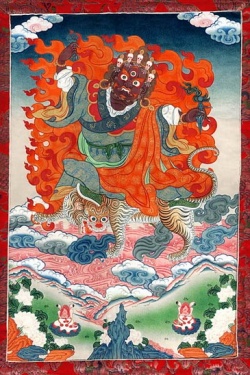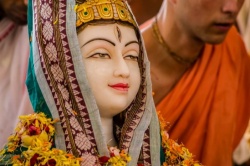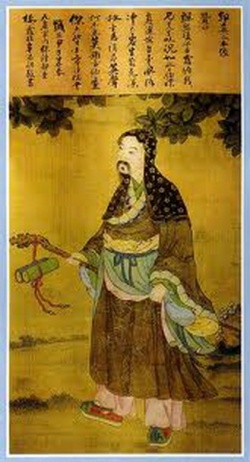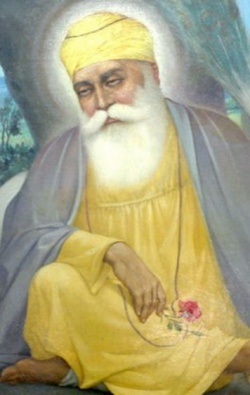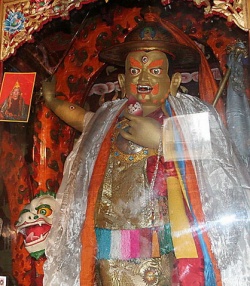Seventeen tantras
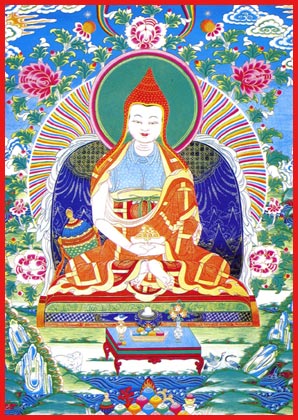
Further Reading
*Khenpo Ngawang Palzang, 'The Dzogchen Scriptures' in Quintessential Dzogchen, edited by Erik Pema Kunsang and Marcia Binder Schmidt (Boudhanath, Hong Kong & Esby: Rangjung Yeshe Publications, 2006), pages 72-75. *Tsele Natsok Rangdrol, Mirror of Mindfulness: The Cycle of the Four Bardos, translated by Erik Pema Kunsang (Boston & Shaftesbury: Shambhala, 1989), Appendix 'The Dzogchen Tantras' (summary of the teachings of Vimalamitra, Longchenpa and Khenpo Ngakchung as recorded in the Nyingtik Yabshyi and its related commentaries.).Source
RigpaWiki:Seventeen tantrasIn Tibetan Buddhism, specifically in the literature and practice of Dzogchen, the seventeen tantras of the esoteric instruction cycle (Tibetan: མན་ངག་སྡེའི་རྒྱུད་བཅུ་བདུན, Wylie: man ngag sde'i rgyud bcu bdun) are a suite of tantras belonging to the textual division known as the "esoteric instruction cycle" (also known variously as: Nyingtik, Upadesha or Menngagde).
History and tradition
The seventeen tantras, though not traditionally classified as a treasure (Wylie: gter ma), nonetheless share in the treasure tradition. They are associated with sacred literature first transmitted in the human realm by the quasi-historical Garab Dorje (Fl. 55 CE) and passed according to tradition along with other tantras through various lineages of transmission by way of important Dzogchen figures such as Mañjuśrīmitra, Shri Singha, Padmasambhava, Jnanasutra and Vimalamitra. Kunsang (2006) holds that Shri Singha brought the Secret Mantra teachings from beneath the Vajra Throne (Wylie: rdo rje gdan) of Bodhgaya to the 'Tree of Enlightenment in China' (Wylie: rgya nag po'i byang chub shing), where he concealed them in a pillar of the 'Auspicious Ten Thousand Gates Temple' (Wylie: bkra shis khri sgo). Shri Singha conferred the Eighteen Dzogchen Tantras (Tibetan: rdzogs chen rgyud bco brgyad) upon Padmasambhava. The eighteen are The Penetrating Sound Tantra (Tibetan: sgra thal ‘gyur), to which was appended the Seventeen Tantras of Innermost Luminosity (Tibetan: yang gsang 'od gsal gyi rgyud bcu bdun). It should be mentioned here that the Dharma Fellowship (2009) drawing on the work of Lalou (1890–1967) holds the 'Five Peaked Mountain' of "the Land of Cina" (where Cina isn't China but a term for the textile cashmere) the Five Peaked Mountain which Kunsang and others have attributed to Mount Wutai in China is instead a mountain near the Kinnaur Valley associated with the historical Suvarnadwipa (Sanskrit) nation also known as 'Zhang-zhung' in the Zhang-zhung language and the Tibetan language. The Seventeen Tantras are amongst the texts known as the 'Supreme Secret Cycle' the Fourth Cycle and the most sacred tantras in the Nyingma Dzogchen tradition and the Dharma Fellowship (2009) provide a different historical location than Mount Wutai China for the location of concealment which is identified as near the Kinnaur Valley within the Kinnaur District: : It is explained that Sri Simha divided the Pith Instruction into four sub-sections, and these are known as the Exoteric Cycle, the Esoteric Cycle, the Secret Cycle, and the Supreme Secret Cycle. Before his own death he deposited copies of the first three cycles in a rock cut crypt beneath the Bodhivriksha Temple of Sugnam (Sokyam) in the land of Cina. The texts of the Supreme Secret Cycle, however, he hid separately within the pillar of the "Gate of a Myriad Blessings". It is with Vimalamitra (fl. 8th century) that this collection of 'Seventeen Tantras, which are but a portion of Garab's revelation may have first been given their specific enumeration and nomenclature as it was Vimalamitra's disciple, Nyangban Tingzin Zangpo, who concealed the Seventeen Tantra subsequent to Vimalamitra's journey to China, particularly Mount Wutai, for later discovery by Neten Dangma Lhungyal in the Eleventh Century that they enter history in their current evocation, as [Gyatso(1998: pp. 153–154) relates thus:
- "By the eleventh century, both Bonpos and Buddhists were presenting texts they claimed to have unearthed from the place where those texts had been hidden in the past.
Among the earliest Buddhist materials so characterized were the esoteric Nyingtig, or "Heart Sphere", teachings, including the seventeen Atiyoga tantras, which were associated with Vimalamitra, an Indian Great Perfection master invited to Tibet, according to some accounts, by Trisong Detsen in the eighth century. Vimalamitra's Tibetan student, Nyangban Tingzin Zangpo, was said to have concealed these teachings after the master went to China.
The discoverer was Neten Dangma Lhungyal (eleventh century), who proceeded to transmit these teachings to Chetsun Senge Wangchuk, one of the first accomplished Tibetan Buddhist yogins, and to others. The Nyingtig materials were at the heart of the Great Perfection Buddhism and had considerable influence upon Jigme Lingpa, who labelled his own Treasure with the same term."
The Vima Nyingtik itself consists of 'tantras' (rgyud), 'agamas' (lung), and 'upadeshas' (man ngag), and the tantras in this context are the Seventeen Tantras
Enumeration of the Seventeen Tantras
Though they are most often referred to as the Seventeen Tantras, other designations are as Eighteen Tantras when the 'Ngagsung Tromay Tantra' (Wylie: sngags srung khro ma’i rgyud) (otherwise known as the 'Ekajaṭĭ Khros Ma'i rGyud' and to do with the protective rites of Ekajati) is appended to the seventeen by Shri Singha;
and Nineteen Tantras with Padmakara's annexure of the 'Longsel Barwey Tantra' (Wylie: klong gsal bar ba'i rgyud) (Tantra of the Blazing Space of Luminosity).
Samantabhadri is associated with the Longsel Barwey and its full name is 'Samantabhadri's Tantra of the Sun of the Brilliant Expanse]]' (Wylie: kun tu bzang mo klong gsal 'bar ma nyi ma'i rgyud).
According to the seventeen-fold classification, in no particular order, they are as follows:
- 'Self-existing Perfection' (Tibetan: རྫོགས་པ་རང་བྱུང, Wylie: rdzogs pa rang byung)
- 'Without Letters' (Tibetan: ཡི་གེ་མེད་པ, Wylie: yi ge med pa)
- 'Self-liberated Primordial Awareness' (Tibetan: རིག་པ་རང་གྲོལ, Wylie: rig pa rang grol)
- 'Piled Gems' (Tibetan: རིན་པོ་ཆེ་སྤུང་བ, Wylie: rin po che spung ba)
- 'Shining Relics of Enlightened Body' (Tibetan: སྐུ་གདུང་འབར་བ, Wylie: sku gdung 'bar ba)
- 'Reverberation of Sound' (Tibetan: སྒྲ་ཐལ་འགྱུར, Wylie: sgra thal 'gyur)
- 'The Mirror of the Heart of Vajrasattva' (Tibetan: རྡོ་རྗེ་སེམས་དཔའ་སྙིང་གི་མེ་ལོང, Wylie: rdo rje sems dpa' snying gi me long)
- 'The Mirror of the Mind of Samantabhadra' (Tibetan: ཀུན་ཏུ་བཟང་པོ་ཐུགས་ཀྱི་མེ་ལོང, Wylie: kun tu bzang po thugs kyi me long)
- 'Necklace of Precious Pearls' (Tibetan: མུ་ཏིག་རིན་པོ་ཆེའི་ཕྲེང་བ, Wylie: mu tig rin po che'i phreng ba)
- 'Sixfold Expanse of Samantabhadra' (Tibetan: ཀུན་ཏུ་བཟང་པོ་ཀློང་དྲུག, Wylie: kun tu bzang po klong drug)
- 'Union of the Sun and Moon' (Tibetan: ཉི་ཟླ་ཁ་སྦྱོར, Wylie: nyi zla kha sbyor)
- 'Lion's Perfect Expressive Power' (Tibetan: སེང་གེ་རྩལ་རྫོགས, Wylie: seng ge rtsal rdzogs)
Text sources, versions and variations
These Seventeen Tantras are to be found in the Canon of the Ancient School, the 'Nyingma Gyubum' (Tibetan: རྙིང་མ་རྒྱུད་འབུམ, Wylie: rnying ma rgyud 'bum), volumes 9 and 10, folio numbers 143-159 of the edition edited by '
Jamyang Khyentse Rinpoche' commonly known as Dilgo Khyentse Rinpoche (Thimpu, Bhutan, 1973), reproduced from the manuscript preserved at 'Tingkye Gonpa Jang' (Tibetan: གཏིང་སྐྱེས་དགོན་པ་བྱང, Wylie: gting skyes dgon pa byang) Monastery in Tibet.
Adzom Chögar redaction
This 'Adzom Chögar redaction' of the versions of the Seventeen Tantras were secured from Jim Valby who transcribed these texts into Wylie transliteration and these selfsame texts have been uploaded onto Wikisource.
English translations
None of these works as yet has been completely translated into English and made generally available.
The Seventeen Tantras are quoted extensively throughout Longchenpa's (1308 - 1364?) 'The Precious Treasury of the Way of Abiding' (Tibetan: གནས་ལུགས་རིན་པོ་ཆེའི་མཛོད, Wylie: gnas lugs rin po che'i mdzod) rendered in English by Richard Barron and Padma Translation Committee (1998).
This work is one of Longchenpa's Seven Treasuries and the Tibetan text in poor reproduction of the pecha has been graciously made available online by Dowman and E. Gene Smith.
Traditionial and external scholarship
'Tegchö Dzö' (Wylie: theg mchog mdzod) "Treasury of the Sublime Vehicle'" is one of the Seven Treasuries, a collection of seven works, some with auto-commentaries, by the Tibetan Buddhist philosopher and exegete Longchenpa.
The Tegchö Dzö is a commentary on the Seventeen Tantras.
Cuevas (2003: p. 62) comments on the traditional perspective of the Nyingma tradition in the attribution of the Seventeen Tantras to the revelation of Garap Dorje and says:
- "The seventeen interrelated Dzokchen Nyingthik scriptures are accepted by tradition as divine revelation received by the ... mystic Garap Dorje. The Seventeen Tantras nevertheless betrays signs of being compiled over a long period of time by multiple hands. The precise identity of these unknown redactors is a riddle that I hope may soon be solved. Whatever the case, we must accept that the collection in the form it is known to us today consists of several layers of history reflecting diverse influences."
